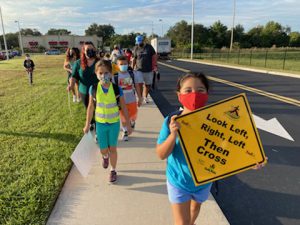Safety is the priority for any Walk, Bike & Roll to School Day event. Follow these steps to plan for a safe event by selecting the best route and working with the community. For more information see the specific resources for pedestrian and bicycle safety below.

Orlando, FL
A local traffic engineer or public works official could also offer helpful input regarding complex routes.
While law enforcement officers have been involved in many Walk & Roll to School Day and Bike & Roll to School Day events in the past, individual communities and schools need to understand their families’ preferences in having law enforcement present for an event. For some community members, negative experiences with law enforcement mean that they may not feel comfortable with any level of law enforcement involvement. For others, law enforcement involvement in Walk & Roll to School Day and Bike & Roll to School Day events can help build trust and open dialogue.
Before the event, talk to the principal and other members of the planning team to identify potential issues and how to address them. Potential safety concerns that may be mentioned include:
These issues don’t have to be event-stoppers, but they will certainly influence the event’s structure. Whether the concerns are real or perceived, they should be addressed so that students, families and leaders feel comfortable. Often, events are used to prompt bigger conversations about how to address any barriers that get in the way of children walking and bicycling to school safely on a regular basis. If routes are missing sidewalks or if there’s a park that would make a great connector to a nearby neighborhood but it doesn’t feel safe, there’s a two-fold approach: 1. Make a plan for the event. 2. Use the event to bring attention to safety concerns that need to be addressed so that students can walk on a regular basis.
Students need to know pedestrian safety skills. Information in the resources below can be taught in the classroom or sent home with students to practice skills with their families. Ideally they get several opportunities to practice what they learn with adults who can provide feedback and supervision.
Teaching students safe biking skills is a key part of starting a bicycling program. The information in the resources below can be taught at school, or sent home with students to practice skills with their families. Ideally students get chances to hear and practice the information several times with adults who can provide feedback and supervision.
Micromobility includes modes such as scooters and skateboards in addition to bicycles. For a general guide on micromobility, see this fact sheet from the Federal Highway Administration. Below are resources on other modes that students may use to get to school as well as recommendations on the use of motorized devices.
For further resources on micromobility visit the Pedestrian and Bicycle Information Center.